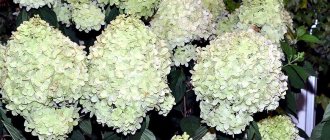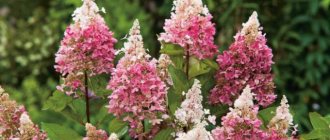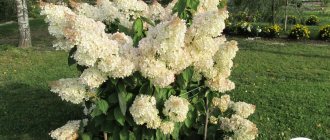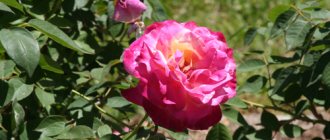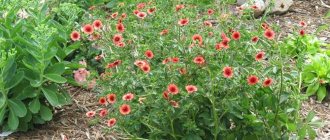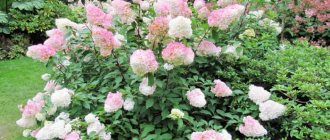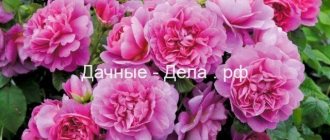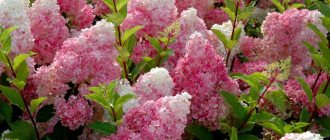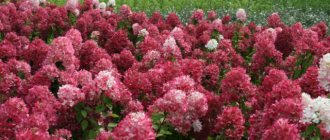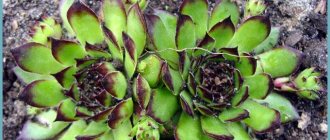History of selection
Hydrangea Fraise Melba is a new product from the collection of the French selector Jean Reno, bred in the 20th century. The appearance of the hybrid flower was preceded by a long (10 years) and painstaking work. The name of the variety is given in honor of the strawberry dessert with cream due to the pyramidal shape of the inflorescences, white at the top and red at the base.
Hydrangea Frize Melba - a new hybrid shrub
Technical data
This type of hydrangea, Fraise Melba Renba, was developed in the mid-20th century. Jean Reno. Then the breeding activities of scientists concentrated on obtaining the paniculate Vanilla variety. Many years of experiments ended in 2014 with the creation of the hybrid hydrangea Fraise Melba, which immediately gained worldwide popularity. The reason for this is the ability to breed it in different climatic conditions.
Technical characteristics of the plant:
- The height of the bush ranges from 1.7 to 2.1 m. The branches are rigid, almost straight, painted burgundy with a brown tint.
- The leaves are ordinary, narrow, with a serrated structure of raised edges, and are egg-shaped. They form a “boat”. Painted in dark shades of green.
- The inflorescence looks like a pyramid. The average length is 0.3-0.4 m, and with appropriate care the size increases to 0.45-0.55 m.
Description of colors:
- they are densely located throughout the cone;
- the initial milky color of the petals first becomes pink and then acquires a crimson color;
- when blooming, the inflorescence retains white tones;
- at the beginning of autumn, some types of this hybrid change the color of the tips of the petals.
This hydrangea blooms at the end of July, and the process continues until late autumn. Frez Melba hydrangea is not afraid of extreme cold. This variety grows quickly. To obtain large inflorescences, the summer resident must prune the hybrid in early spring.
Important! If the petals of the plant are dried under the rays of the sun, they retain their original aroma for a long time.
Planting and care
Hydrangea paniculata freise melba needs calcium, as without it it will not grow. For better growth of shrubs, you need to add lime to the soil in small quantities to avoid excessive liming of the soil. This variety is absolutely unpretentious in care and planting.
Fraise melba loves water very much, so after planting it is necessary to water the plant generously, then water it often and a lot, especially on hot days. In summer, watering should be daily. The shrub feels best in a shaded place, where it will grow vigorously and bloom for a long time. By the way, this beauty blooms in the first year after planting, even if the bush was damaged by frost, it requires very little time to recover. The inflorescences of this variety can reach thirty centimeters in diameter and resemble lilac inflorescences.
Paniculata blooms longer - from July to October. The color palette of different varieties is varied and it can even change during the flowering period. Another feature of it is its period of life. She can live up to forty years in one place. If you organize proper care for the shrub, it will show all its flowering beauty and will grow quickly.
The main condition for this shrub is the soil at the planting site, rich in minerals, sand, and peat. For better growth, fries melba needs calcium, which is contained in lime. Fertilizing can be done several times a year using saltpeter and manure. It is better not to add nitrogen fertilizers in the spring, as they may prevent the plant from overwintering. Be sure to mulch the soil and remove wilted inflorescences. This will prolong the flowering of this beautiful shrub.
Direct sunlight has a detrimental effect on the size of the inflorescences. If a hydrangea is planted in an open area, then most likely its inflorescences will become smaller over time. Also, the size of the inflorescences is greatly influenced by timely pruning in the spring. After all the inflorescences have faded, they must be pruned in the fall, and the affected shoots must be pruned in the spring.
Description of hydrangea Frize Melba
Hydrangea Melba Frazee is a paniculate ornamental shrub reaching a height of 2 m, looks compact and does not require garter. The branches of a young plant have a dark red tint, becoming brown over time. Round green foliage, pointed at the edges, is attached to the shoots with long petioles. Branching on straight growing shoots is excluded.
Large openwork inflorescences (40-55 cm long), similar to a pyramid, change color during flowering: pink petals turn white, light petals become brown, the upper part remains white.
The peak of flowering of hydrangea Frize Melba occurs in mid-summer, lasts until frost, no fruit is formed. Inflorescences appear annually, immediately after planting. No additional care is required for the hybrid. The plant lives 30-40 years.
Interesting fact. It is unlikely that hydrangea will become diseased; Frize Melba is a resistant variety. Diseases develop when growing a flower in a corner with a lack of sunlight, lack of fertilizers, and lack of access to fresh air. The novelty is also of little interest to insects.
The disadvantages of the crop include the difficulty of obtaining seeds and susceptibility to fungal diseases. The variety does not cope well with drought and rots when there is an excess of moisture.
Decor of garden paths with hydrangea Frez Melba in the Urals
General information
Hydrangea Frize Melba blooms profusely from spring to autumn. The color scheme of the hybrid gives unusual transitions from crimson to white shades, decorating the edges of the petal part, elongated in the shape of an elongated pyramid.
A distinctive feature of the plant is its flowering in the first year after planting. Moreover, this process occurs regardless of the condition of the bush. No additional care is needed for the hybrid. The paniculate form of Frize differs from its ancestors in its increased frost resistance and the ability to change color throughout the year: pink petals turn white, and light ones acquire a crimson color. The plant can live 30-40 years
Hydrangea Frize Melba
Botanical description
Paniculata hydrangea is an ornamental, profusely flowering shrub, frost-resistant and unpretentious. The Fraise Melba variety was obtained by the French breeder Jean Reno. The variety was presented at the Moscow exhibition in 2014.
Work on the Fraise Melba hydrangea lasted for 10 years. The variety got its name from the famous strawberry dessert. The shrub produces large pyramidal inflorescences that change color from white to burgundy. The contrast between the white top and red base is reminiscent of strawberries and cream.
Panicle hydrangea Frize Melba reaches 2 m in width and height. The bush has a compact appearance. The shoots are erect, brownish-burgundy in color.
The leaves are small, petiolate, located along the entire length of the shoots. Inflorescences form at the tops. The flowers are sterile; after flowering, no fruits are formed.
Important! Flowering of the Fraise Melba variety begins in mid-July and lasts until the end of September. Inflorescences are 30-40 cm long, with good agricultural technology they reach 55 cm.
Paniculata hydrangea looks good in single plantings, on lawns, and next to ornamental shrubs. It is used to decorate garden plots, greenhouses, parks and recreation areas. The Frize Melba variety is suitable for creating a hedge.
Features of the variety
The variety became widely available 5 years ago. Gardeners who have been growing hydrangea Frize Melba for several years note that it is a fairly large shrub. Indeed, according to the characteristics of the variety, the height of the plant can reach 2 meters. At the same time, not too branched, as well as strong and tough shoots allow the bush to maintain a compact shape and neat appearance.
The branches are dark in color, closer to burgundy. The shoots become woody and brown with age. The leaves of the shrub are dark green, shaped characteristic of hydrangea, slightly pointed at the top and wedge-shaped at the base, firmly attached to the branches by petioles.
The pyramidal inflorescences consist of a huge number of small flowers. The size of the inflorescences corresponds to the height of the bush, they are just as large and powerful, their length can range from 40 to 55 cm. At the very beginning, the buds are white, and at the peak of flowering only the top remains white, the bottom acquires a rich wine-red hue. It is for this color, as well as the shape of the buds, that the variety received its name, which translates as “strawberries with cream.” Long flowering is another feature of the variety. The bush begins to bloom in the second ten days of July, and ends in mid-autumn, decorating the area throughout almost the entire season.
Features of care
This variety of hydrangea blooms from mid-July until the first frost, but large inflorescences can only be obtained with proper pruning. In spring, it is necessary to trim all shoots short, repeating the procedure every year.
Another important condition for good flowering is abundant watering. The soil should not be allowed to dry out; the plant is moisture-loving, and during periods of drought it should be watered every day.
An important feature of the Freise Melba hydrangea: it needs calcium to grow, so the plant is fed with mineral fertilizers twice a month and lime is occasionally added to the soil. Lime should be added carefully to prevent excessive liming of the substrate.
The plant is recommended to be planted in spacious sunny areas; light shade from tall trees is acceptable. The variety is resistant to frost and can winter in open ground conditions in temperate latitudes (for example, in the Moscow region). The bush is covered for the winter in cold regions where the temperature drops below 30 degrees below zero. To cover hydrangeas they traditionally use:
- fallen leaves;
- rotted manure or peat;
- spruce or pine spruce branches;
- burlap.
You can use modern materials - spandbond or geotex - and if the bush is too large, a frame should be built over it to avoid mechanical damage to the shoots under the weight of snow.
In good conditions, hydrangea Fraze Melba grows quickly and retains the ability to flower for up to 40 years.
In order for the plant to remain healthy, it is important to ensure that the roots do not turn sour with abundant watering - regularly loosen the soil to a depth of 5-7 cm. Sometimes tall shoots with heavy inflorescences require support
This variety is perfect for creating hedges. To obtain daughter shrubs, it is recommended to use green or lignified cuttings, which quickly take root and can form a new flowering bush as early as next year. Rooted cuttings are planted in holes filled with a mixture of acidic peat, humus and garden soil. Planting is best done in spring. After autumn planting of hydrangea, it is recommended to protect it from severe frosts, despite its winter hardiness.
Hydrangea paniculata Freise Melba is an unpretentious plant with spectacular large wine-red inflorescences with white tips. Regular watering, good lighting, annual pruning and timely mineral fertilizing will allow you to enjoy the bright colors of hydrangea in the garden for a long time.
When trying to decorate your garden plot, you should pay attention to a new selection - paniculate hydrangea Frize Melba, the description of the variety is very attractive. It appeared here quite recently - in 2014, after ten years of work by a French breeder who was able to create such an unpretentious and amazingly beautiful plant
Description of hydrangea paniculata Frize Melba
The hydrangea shrub has a small height - about 2 meters and the same circumference. It is difficult to call it compact, but in large areas it does not seem huge. From the description of the paniculate hydrangea Fraise Melba it follows that the bush has erect, rigid shoots that do not require garter, and the plant perfectly retains its shape throughout the entire growing season.
The leaves of Frize Melba are dark green, glossy, perfectly in harmony with the bright red petioles. But the most beautiful and surprising thing that amazes us in the plant of this variety is the huge, up to 45 cm, cone-shaped inflorescences with an extraordinary transition of shades.
At the beginning of flowering, the bud, consisting of many small flowers, is white. Gradually it changes to soft pink, and at the end it acquires a wine tint, and the tip of the inflorescence is always lighter than the base, which gives the plant a peculiar charm.
In our latitudes, in order to preserve the variety, good winter shelter is required for most plants. Frize Melba does not require this, as it has excellent frost resistance.
Another advantage of this hydrangea is the ability to grow it in the shade. This perennial loves shady places and moist soil. However, you cannot do without good drainage. In order for hydrangea to develop well and bloom profusely, it will need shoots pruned in early spring.
Application in landscape design
Hydrangea variety "Fries Melba" is loved by many connoisseurs of exquisite phytodesign. It is used in decorating gardens and parks when creating hedges, landscape compositions and single plantings. The “Fries Melba” type combines well in plantings with phlox and sedum; ensembles with other varieties of hydrangeas and rhododendrons are very effective. Landscape designers do not recommend planting more than 3-4 hydrangea bushes in separate flowerbeds, and with “Fries Melba” it is better to plant 2-3 bushes of other varieties of hydrangea with different petal colors. Single planted "Fries Melba" looks impressive on lawns.
Using flowers in garden decoration
Garden decoration
Many lovers decorate their summer cottages with paniculata hydrangea Fraise Melba. With the help of these flowers, various landscape compositions are created. Plants of this type go well with sedum or phlox. Ensembles that are pleasing to the eye are made from different varieties of hydrangeas, rhododendrons, and cuffs. But it is not recommended to plant Melba hydrangeas next to birch trees due to possible competition for moisture.
When planting flowers in separate flower beds, you should try to ensure that each of them contains no more than 3-4 bushes. It is advisable to breed 2-3 varieties with different colors of petals.
To diversify your flower garden with this perennial variety, you won’t need much effort. The main thing is to select a high-quality seedling, check it for lesions and water it abundantly after planting. And then the first flowering of hydrangea will not take long.
5 1 vote
Article rating
Reproduction methods
Propagation of paniculate hydrangea can be carried out in many ways: cuttings, layering, divisions and seeds. The first of them is considered the simplest and most productive method of obtaining new plant specimens.
Cuttings
The plant will take root well if you follow the basic recommendations for cuttings. Experienced gardeners cut sprouts from the bush in the early morning or in cloudy weather. Green cuttings 10 cm long are cut from annual shoots, leaving the upper leaves shortened by a third with several buds. The shoots connected by a bunch at the bottom are treated with a growth stimulator, the upper cut is disinfected with brilliant green and planted at an angle in containers.
The substrate for shrubs is prepared on the basis of turf, peat and sand, in a ratio of 1:3:4. The cutting is placed in a dug groove 5 cm deep. The soil is first disinfected in the oven at a temperature of 200 degrees. A more convenient option would be to use ready-made soil mixture for azaleas.
The sprouts are covered with glass jars and ventilated weekly for 15 minutes. Over the course of a month, the cuttings take root and the cover is removed. In areas with a mild climate, the shoots are planted in moist loamy soil; in winter, the shoots are carefully covered. In the northern climate zone, rooted hydrangea is left in a cool room until next spring.
Preparing cuttings for planting
Growing from seeds
You can often see seedlings on sale rather than seeds, as this is a faster way to get a plant. The inflorescences of this plant are sterile, and therefore it will not be possible to collect planting material at home; it can be purchased in specialized stores.
Varieties of paniculata hydrangea
We are sometimes asked to list the “names of paniculate hydrangeas”, the most popular in cultivation and at the same time the least capricious to care for, and are also asked to recommend varieties of paniculate hydrangea for the Moscow region. Actually, any variety of this species is winter-hardy enough for moderately frosty winters, but in conditions of abnormal cold, they all need shelter for the root zone.
We offer you the best varieties of paniculata hydrangea.
Hydrangea paniculata Grandiflora (large-flowered)
A shrub that over time takes the form of a tree up to 3 m high. It is distinguished by later flowering than other varieties. Collected in wide pyramidal inflorescences up to 30 cm long, the large sterile flowers of this variety are creamy when blooming, pure white in full bloom, and then pinkish - becoming greenish-red closer to autumn. The lifespan of plants of this variety is about 30 years;
Hydrangea paniculata Vanilla Fraze
The plant is up to 150 cm high and has a crown of the same diameter. The inflorescences are large, similar to lilac clusters. The flowers are creamy at first, then they turn pink, and towards the end of flowering they become dark red. One bush can have snow-white and bright crimson flowers at the same time. Plants of this variety can withstand frosts down to -29 ºC;
Hydrangea paniculata Phantom
A plant up to 2 m high with a crown diameter of the same size. The inflorescences of this variety are large, dense, round-pyramidal. The flowers are light cream in color when opening, but become pinkish over time;
Hydrangea paniculata Pink Diamond
The inflorescences of this variety, up to 30 cm long, consist of creamy white flowers that gradually acquire a dark pink, almost red color;
Hydrangea paniculata Limelight
A plant extremely popular among designers due to its strong shoots that easily withstand heavy greenish inflorescences, which turn white in bright sun and pink towards the end of flowering. The leaves of this variety are green in spring and summer and turn purple in autumn;
Hydrangea paniculata Pink Lady
A fan-shaped shrub up to 2 m high with a spreading crown, straight brown shoots that acquire a reddish tint in autumn, and white inflorescences up to 30 cm long. Over time, a light blush appears on the fragrant white flowers, then the flowers gradually become soft pink;
Hydrangea paniculata Magical Candle
A plant with a spreading crown and large pyramidal inflorescences of light cream and green fragrant flowers, which turn pink in summer and crimson in autumn;
Hydrangea paniculata Vims Red
A plant with inflorescences up to 35 cm long, conical in shape, emitting a honey aroma. During the season, the flowers turn from white to pink, and at the end of flowering - deep red;
Hydrangea paniculata Diamond Rouge
A compact upright shrub with inflorescences up to 40 cm long, the flowers of which are initially white and then acquire a rich crimson-red color;
Hydrangea paniculata Sunday Fries
Dense compact bush with red-brown shoots, pubescent leaves along the veins and white flowers, which become lilac-pink by the end of summer;
Hydrangea paniculata Pinky Winky
A variety that was bred more than 10 years ago, but still has not lost its popularity. This is a small tree or bush with a wide-rounded crown and shoots that grow up to 30 cm annually. Powerful stems bear paniculate inflorescences of white flowers, which change color to pink-purple during the season;
Hydrangea paniculata Melba Fraze (Fraiz Melba)
A new variety, which is a tall bush with dark burgundy shoots with a brown tint and dense pyramidal inflorescences 45-55 cm long, consisting of milky white flowers, gradually acquiring at first a soft pink, and towards the end of flowering a rich wine-red hue.
In addition to those described, the following varieties of hydrangea paniculata are grown in culture: Silver Dollar, Little Lime, Kyushu, Bobo, Tardiva, Presox, Unique, Floribunda, Matilda, Darts Little Dot, Brussels Lace and others.
Growing conditions
Let's find out where to place this hydrangea on the site, what conditions need to be maintained for its health and beautiful flowering.
Lighting and location
The plant has no special complaints about the choice of its location: planting the Fraise Melba hydrangea is permissible both in partial shade and in the sun. It is important, however, to protect the flower from direct sun during the midday hours. Strong shadow is not suitable.
Since this is a hydrangea, soil moisture levels are very important. Choose a place so that the roots of the flower remain moist for a long time. Dry areas are only permissible if you have the opportunity to water the plant frequently.
Temperature
In general, the plant is frost-resistant. Bred by domestic breeders, this hydrangea can withstand frosts down to -30-35 degrees. And this is without shelter. If in your region the frosts drop even lower in winter, take care of covering the hydrangea in the fall.
Also make sure that the flower is protected from gusty winds and drafts. Hydrangea does not like sudden changes in temperature. It is optimal to plant it under the protection of a house wall or fence on the north side.
Humidity
This flower will not survive without moisture - like all hydrangeas, Fraise Melba is very dependent on water. Plant it in well-moistened soil (but not waterlogged!), and do not forget about regular watering during the growing process. If the summer is hot, daily watering is required - only this approach will preserve the health and external beauty of the plant.
Priming
This beauty should be grown in a fertile substrate, with a predominance of clay. The soil should be slightly acidic - this will ensure the brightness of the buds. By planting the plant in alkaline, calcareous soil, you will get nondescript inflorescences of a pale shade.
So, we found out what the Frize Melba hydrangea is. This amazing shrub amazes with its exquisite beauty and unusual gradient flower caps. Due to the fact that the variety is domestic, it is unpretentious and adapted to the conditions of our climate, environment and soil.
Selection and conditions of detention
There are nuances in growing Pinky Winky that a novice gardener should know about in advance, although at first glance everything seems quite standard.
Selecting a location
Hydrangea Pinky Winky has a well-developed root system that lies close to the soil surface. This means that when choosing a site for a flower, you should immediately select a permanent place, since it will not tolerate frequent transplants.
In heavily shaded flower beds, Pinky Winky blooms weakly, and the petals of its buds become pale. At the same time, the scorching sun can cause burns on the leaves. Therefore, you need to choose places with shading, but well-lit for half the day.
The growth of hydrangeas is negatively affected by proximity to plants that have a shallow root system, since the bush will not have enough nutrients for nutrition. It is worth paying close attention to the choice of Pinky Winky’s “neighbors”.
You also need to take into account that these plants do not take root well in areas where groundwater flows close.
Important! To prevent paniculate inflorescences from getting sick from exposure to drafts, you need to select a place that is not blown by winds
Climatic conditions: air, temperature
Pinky Winky feels good in any climate conditions
Pinky Winky does well in any climate. It blooms beautifully in the Ural mountains, in the Leningrad region, and even in the Far East. But amateur gardeners in the southern part of Russia will be especially pleased with the lush and long flowering, since there are more warm days here.
The soil
Hydrangea is picky about soil quality. It needs loose and light soils. Only acidic soils with a pH level of 4.5-5.5 are suitable; alkaline and neutral Pinky Winky soil is not recommended. But if there is no other option, then it can be flavored with peat or a special product (for example, acid+).
Plants prefer only fertile soil, so it needs to be constantly fertilized. Experienced gardeners recommend periodically applying organic fertilizers.
Planting hydrangea Frize Melba
In order for Hydrangea paniculata Frize Melba to actively develop, it needs to be provided with proper planting and care.
Recommended timing
Plants of this variety should be planted in the spring, when the last frosts have gone. By this period, the soil is already well warmed up, and constant heat is established outside.
Where to plant
To plant paniculate hydrangea Frize Melba, you can choose either a sunny open place or partial shade. The best option for this variety is a bright area that is shaded during the hot midday sunlight. The crop must be planted in the shade.
To prevent the shrub from breaking due to strong winds, you should plant it near the fence. Constant drafts can cause plant disease.
Preparing soil and seedlings
The land for planting must be fertile. It is best to choose a loamy soil substrate. The soil should have a slightly acidified pH environment. You should not choose land that contains a large amount of limestone or sandstone.
Planting material must be kept in a cool place until planting.
Step by step planting process
Planting of hydrangea Frize Melba is carried out in the following sequence:
- Dig a hole with sides of 50 cm.
- Fill with drainage made of broken brick or expanded clay (10-15 cm).
- Pour a mixture of turf soil mixed with peat and sand. To constantly maintain soil moisture, it is advisable to add hydrogel.
- When planting in the spring, it is recommended to remove young shoots by 3-4 buds, without wasting the plant’s energy on the development of shoots; initially, the crop should grow roots.
- The roots of the seedling are well moistened in the purchased pot.
- The sprout is placed vertically in a wet hole, sprinkled with earth, leaving the root collar on the surface of the soil.
- The soil around the shoots is compacted and watered with two buckets of water.
Planting a sprout takes a minimum of time and does not cause difficulties even for beginners.
The first flowering of the shrub after transplantation
Planting and care
The plant is moisture-loving. If proper care is provided, hydrangea will delight and surprise with a wide range of colors for quite a long time (there are cases when hydrangea blooms in one place for up to forty years). It can be planted both in autumn and spring. The main thing is that the planting process occurs before the sap flow begins.
Landing occurs as follows:
Select a site for planting shrubs. It is desirable that it be fertile and loamy, perhaps with slightly acidified soil. Soil with abundant lime content or sandy soil is not suitable for hydrangea. From sandy soil, water quickly washes away nutrients that are vital for the flower. Also, the shrub does not like a soil mixture mixed with ash. Organic fertilizers from a mixture of peat, garden soil and humus are added to the dug hole intended for planting hydrangeas, mixed, and drained (if necessary). Broken brick, gravel, and foam can be used as drainage. After planting the seedling, it is advisable to add mulch (leaf, peat) under the bush. If planting is done in the fall, it is recommended to cover the plant with a transparent plastic container and covering material. Rotted horse compost is used as mulch for autumn planting, which will additionally provide warmth to the root system in early spring, and when the snow melts, the flower will receive excellent nutrition. In the case when covering material was used to cover the period of winter cold, at the very beginning of spring it should be removed in a timely manner in order to prevent the buds from rotting and dying
It is important to know that when planting, the root collar is allowed to be buried about two centimeters. But if frosts have slightly damaged the bush, you shouldn’t be upset.
After a short period of time, the hydrangea will quickly recover and bloom with the splendor of colors. Due to the fact that the plant has a superficial root system, it is necessary to prevent their exposure. In order to prevent overheating, soil is periodically added or covered with mulching material (mown grass, dry leaves, etc.). Fertilizing is done with saltpeter, manure, and calcium-based mineral fertilizers. The use of nitrogen fertilizers is prohibited. It is recommended to feed twice a month; After the panicles have faded, the bush requires proper pruning, which removes wilted inflorescences, dry and damaged branches. Despite the fact that hydrangea paniculata Frize Melba is resistant to winter cold, in regions where winter temperatures drop below 30 0C, it is recommended to cover it with spruce branches, peat, foliage, snow, film, etc.
Caring for hydrangea Fraze Melba
In order for the Fraze Melba hydrangea to continue to delight its owners with its beautiful blooms, it needs to be provided with the care it needs. The main conditions for maintaining the life of this variety are watering, pruning, mulching and fertilizing.
Watering
This variety, like all hydrangeas, is a moisture-loving crop, so proper watering is the most important element of agricultural technology. In a dry summer, without watering, the bush will dry out. Abundant watering is necessary 3-4 times a week. In hot, dry times you will have to water daily. However, you should also not over-moisten the soil to prevent rotting of the roots. In rainy weather, depending on the intensity of the rain, watering is reduced or stopped altogether.
Feeding
The Fraze Melba variety is fed with organic matter and mineral complexes. Several treatments are carried out during the season.
Feeding scheme for hydrangea Frize Melba:
- before buds open in spring;
- at the beginning of budding;
- in midsummer;
- in the fall before preparing for winter.
For the first feeding, an infusion is prepared based on organic components: bird droppings or mullein. The fertilizer is poured with water in a ratio of 1:15 and left to infuse for 2 days. The resulting product is used to water the Freise Melba variety at the root.
Growing hydrangeas in the garden
Hydrangea in the garden
Hydrangea Polar Beer - variety description, planting and care
Plant care involves the following operations:
- Feeding the bushes with fertilizers is carried out once every 10 days. First, nitrogen mixtures are used, then during the development of inflorescences the hybrid is transferred to potassium and phosphorus solutions. Fertilizers are applied for the last time in the fall. From organic substances, humus or slurry is used.
- The variety loves watering. To do this, you need water with a pH of no more than 5.5. Irrigation is carried out 3 times a week. If the summer is hot, it is recommended to increase the volume of water used by 2-3 times.
- After planting, the soil is loosened 3 times per season. The depth of immersion of the tool into the ground should not exceed 50-100 mm. This operation can be combined with watering.
- The variety must be protected from various weeds. They are weeded every week.
Important! It is recommended to constantly update the mulch, otherwise the hydrangea will begin to wither from overheating.
Pruning hydrangea Melba is done as follows:
- after the buds swell in the spring, cut the bushes to 1/3 of their length;
- before wintering, the branches of young seedlings are reduced to 3-4 buds;
- the old plant is cut off at the root;
- The formation of cuttings is carried out over 4-5 years.
Important! If the variety blooms for the first time, it is recommended to remove the buds. This will allow you to get a more luxuriant crown next year.
Diseases and pests
The Frize Melba variety is immune to diseases, but errors in planting and care can lead to unpleasant consequences. Fungal diseases and rot affect hydrangea if it is planted in the shade and on marshy soil. Constant cold winds and drafts reduce plant immunity. To prevent fungal diseases in spring and autumn, hydrangea must be treated with the preparation “HOM”. Insect pests (snails, weevils, bedbugs, aphids) are destroyed with insecticides. It is important to constantly monitor the condition of the plant. If any symptoms appear, you must immediately take effective measures, and not rely on the Russian “maybe” and do not wait for the disease to take over the entire bush.

